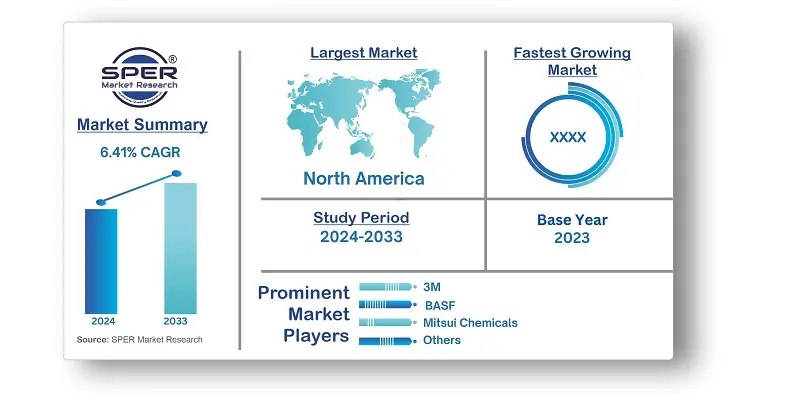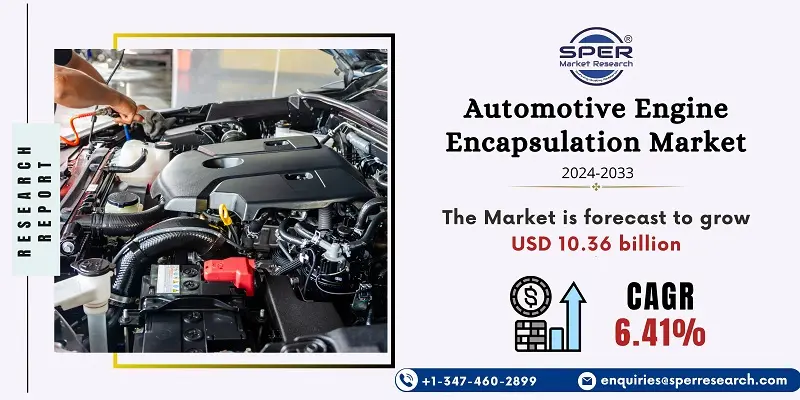
Automotive Engine Encapsulation Market Trends, Share, Demand, Competition and Future Outlook
Automotive Engine Encapsulation Market Growth, Size, Trends Analysis- By Vehicle Type, By Material Type, By Fuel Type- Regional Outlook, Competitive Strategies and Segment Forecast to 2033
| Published: Oct-2024 | Report ID: AMIN24228 | Pages: 1 - 247 | Formats*: |
| Category : Automotive & Transportation | |||
- October 2023; Freudenberg created a unique heat shield especially for batteries used in electric vehicles. Excellent heat management and fire resistance are features of this shield that are essential for EV performance and safety.
- September 2023; Covestro and BASF collaborated to create engine encapsulation solutions that are lightweight. Using Covestro polycarbonates and BASF polyamides, the two chemical conglomerates worked together to develop lightweight engine encapsulating parts. This partnership seeks to increase fuel efficiency while lowering vehicle weight.


| Report Metric | Details |
| Market size available for years | 2020-2033 |
| Base year considered | 2023 |
| Forecast period | 2024-2033 |
| Segments covered | By Vehicle Type, By Material Type, By Fuel Type |
| Regions covered | North America, Asia-Pacific, Latin America, Middle East & Africa and Europe |
| Companies Covered | 3M, BASF, Covestro, Dow, Freudenberg, Henkel, Huntsman, Mitsui Chemicals, Roush Industries, Saint-Gobain. |
- Automotive Manufacturers
- Tier 1 Suppliers
- Tier 2 Suppliers
- Original Equipment Manufacturers (OEMs)
- Automotive Engineers
- Automotive Designers
- Aftermarket Parts Retailers
- Regulatory Agencies
| By Vehicle Type: | |
| By Material Type: | |
| By Fuel Type: |
- Global Automotive Engine Encapsulation Market Size (FY’2024-FY’2033)
- Overview of Global Automotive Engine Encapsulation Market
- Segmentation of Global Automotive Engine Encapsulation Market By Vehicle Type (Passenger Cars, Light Commercial Vehicles, Heavy Commercial Vehicles, Others)
- Segmentation of Global Automotive Engine Encapsulation Market By Material Type (Carbon Fiber, Polyurethane, Polypropylene, Polyamide, Glass wool)
- Segmentation of Global Automotive Engine Encapsulation Market By Fuel Type (Gasoline, Diesel)
- Statistical Snap of Global Automotive Engine Encapsulation Market
- Expansion Analysis of Global Automotive Engine Encapsulation Market
- Problems and Obstacles in Global Automotive Engine Encapsulation Market
- Competitive Landscape in the Global Automotive Engine Encapsulation Market
- Impact of COVID-19 and Demonetization on Global Automotive Engine Encapsulation Market
- Details on Current Investment in Global Automotive Engine Encapsulation Market
- Competitive Analysis of Global Automotive Engine Encapsulation Market
- Prominent Players in the Global Automotive Engine Encapsulation Market
- SWOT Analysis of Global Automotive Engine Encapsulation Market
- Global Automotive Engine Encapsulation Market Future Outlook and Projections (FY’2024-FY’2033)
- Recommendations from Analyst
1.1. Scope of the report1.2. Market segment analysis
2.1. Research data source2.1.1. Secondary Data2.1.2. Primary Data2.1.3. SPER’s internal database2.1.4. Premium insight from KOL’s2.2. Market size estimation2.2.1. Top-down and Bottom-up approach2.3. Data triangulation
4.1. Driver, Restraint, Opportunity and Challenges analysis4.1.1. Drivers4.1.2. Restraints4.1.3. Opportunities4.1.4. Challenges4.2. COVID-19 Impacts of the Global Automotive Engine Encapsulation Market.
5.1. SWOT Analysis5.1.1. Strengths5.1.2. Weaknesses5.1.3. Opportunities5.1.4. Threats5.2. PESTEL Analysis5.2.1. Political Landscape5.2.2. Economic Landscape5.2.3. Social Landscape5.2.4. Technological Landscape5.2.5. Environmental Landscape5.2.6. Legal Landscape5.3. PORTER’s Five Forces5.3.1. Bargaining power of suppliers5.3.2. Bargaining power of buyers5.3.3. Threat of Substitute5.3.4. Threat of new entrant5.3.5. Competitive rivalry5.4. Heat Map Analysis
6.1. Global Automotive Engine Encapsulation Market Manufacturing Base Distribution, Sales Area, Product Type6.2. Mergers & Acquisitions, Partnerships, Product Launch, and Collaboration in Global Automotive Engine Encapsulation Market
7.1. Global Automotive Engine Encapsulation Market Size, Share and Forecast, By Vehicle Type, 2020-20267.2. Global Automotive Engine Encapsulation Market Size, Share and Forecast, By Vehicle Type, 2027-20337.3. Passenger Cars7.4. Light Commercial Vehicles7.5. Heavy Commercial Vehicles7.6. Others
8.1. Global Automotive Engine Encapsulation Market Size, Share and Forecast, By Material Type, 2020-20268.2. Global Automotive Engine Encapsulation Market Size, Share and Forecast, By Material Type, 2027-20338.3. Carbon Fiber8.4. Polyurethane8.5. Polypropylene8.6. Polyamide8.7. Glass wool
9.1. Global Automotive Engine Encapsulation Market Size, Share and Forecast, By Fuel Type, 2020-20269.2. Global Automotive Engine Encapsulation Market Size, Share and Forecast, By Fuel Type, 2027-20339.3. Gasoline9.4. Diesel
10.1. Global Automotive Engine Encapsulation Market Size and Market Share
11.1. Global Automotive Engine Encapsulation Market Size and Market Share By Region (2020-2026)11.2. Global Automotive Engine Encapsulation Market Size and Market Share By Region (2027-2033)11.3. Asia-Pacific
11.3.1. Australia11.3.2. China11.3.3. India11.3.4. Japan11.3.5. South Korea11.3.6. Rest of Asia-Pacific11.4. Europe11.4.1. France11.4.2. Germany11.4.3. Italy11.4.4. Spain11.4.5. United Kingdom11.4.6. Rest of Europe11.5. Middle East and Africa11.5.1. Kingdom of Saudi Arabia11.5.2. United Arab Emirates11.5.3. Qatar11.5.4. South Africa11.5.5. Egypt11.5.6. Morocco11.5.7. Nigeria11.5.8. Rest of Middle-East and Africa11.6. North America11.6.1. Canada11.6.2. Mexico11.6.3. United States11.7. Latin America11.7.1. Argentina11.7.2. Brazil11.7.3. Rest of Latin America
12.1. Adient12.1.1. Company details12.1.2. Financial outlook12.1.3. Product summary12.1.4. Recent developments12.2. BASF12.2.1. Company details12.2.2. Financial outlook12.2.3. Product summary12.2.4. Recent developments12.3. Continental AG12.3.1. Company details12.3.2. Financial outlook12.3.3. Product summary12.3.4. Recent developments12.4. DBM Reflex12.4.1. Company details12.4.2. Financial outlook12.4.3. Product summary12.4.4. Recent developments12.5. DuPont12.5.1. Company details12.5.2. Financial outlook12.5.3. Product summary12.5.4. Recent developments12.6. Grupo Antolin12.6.1. Company details12.6.2. Financial outlook12.6.3. Product summary12.6.4. Recent developments12.7. HushMat12.7.1. Company details12.7.2. Financial outlook12.7.3. Product summary12.7.4. Recent developments12.8. Novelis12.8.1. Company details12.8.2. Financial outlook12.8.3. Product summary12.8.4. Recent developments12.9. Saint-Gobain12.9.1. Company details12.9.2. Financial outlook12.9.3. Product summary12.9.4. Recent developments12.10. Others
SPER Market Research’s methodology uses great emphasis on primary research to ensure that the market intelligence insights are up to date, reliable and accurate. Primary interviews are done with players involved in each phase of a supply chain to analyze the market forecasting. The secondary research method is used to help you fully understand how the future markets and the spending patterns look likes.
The report is based on in-depth qualitative and quantitative analysis of the Product Market. The quantitative analysis involves the application of various projection and sampling techniques. The qualitative analysis involves primary interviews, surveys, and vendor briefings. The data gathered as a result of these processes are validated through experts opinion. Our research methodology entails an ideal mixture of primary and secondary initiatives.



Frequently Asked Questions About This Report
PLACE AN ORDER
Year End Discount
Sample Report
Pre-Purchase Inquiry
NEED CUSTOMIZATION?
Request CustomizationCALL OR EMAIL US
100% Secure Payment






Related Reports
Our Global Clients
Our data-driven insights have influenced the strategy of 200+ reputed companies across the globe.






















